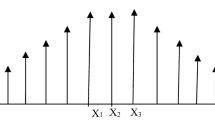Abstract
Next-generation optical communication networks require high input power and more number of channels at low spacing. This can be achieved using dense wavelength division multiplexing (DWDM). However, increasing the number of channels and decreasing channel spacing can enhance fiber nonlinearities, especially the four-wave mixing (FWM). In this paper, different modulation techniques and optical filters are considered and investigated to reduce the FWM effect in DWDM optical communication systems. System performance is evaluated through its quality factor (Q-factor), optical signal-to-noise ratio, optical received power and FWM efficiency. All used techniques have shown a reduction in FWM efficiency. The highest reduction in FWM efficiency is 25 dB and is reported while using modified Duobinary modulation with an increase of 2 in the Q-factor. A comparative study is carried out for the different techniques at 10–20 Gbps bit rate. All simulations are performed through Optisystem.
















Similar content being viewed by others
References
Bi M, Xiao S, Li J, He H (2014) A bandwidth-efficient channel allocation scheme for mitigating FWM in ultra-dense WDM-PON. Optik Int J Light Electron Optics 125(8):1957–1961
ElRazak BKA, Aly MH (2009) Suppression of four wave mixing crosstalk in four 10 Gbps channels over a 50 km dispersion shifted fiber using unequal channel spacing. In: Proceeding of the 19th international conference on computer: theory & applications, ICCTA, pp 228–233
ElRazak BKA, Saleh MB, Aly Moustafa H (2011) Duobinary modulation format and unequal channel spacing integration to suppress four-wave mixing crosstalk in WDM systems. In: Proceeding of the 2011 IEEE Saudi international conference on electronics, communications and photonics (SIECPC), pp 1–5
Fukuda H, Yamada K, Shoji T, Takahashi M, Tsuchizawa T, Watanabe T, Itabashi SI (2005) Four-wave mixing in silicon wire waveguides. Opt Express 13(12):4629–4637
Hansryd J, Andrekson PA, Westlund M, Li J, Hedekvist PO (2002) Fiber-based optical parametric amplifiers and their applications. IEEE J Sel Top Quantum Electron 8(3):506–520
Hwang B, Tonguz OK (1998) A generalized suboptimum unequally spaced channel allocation technique. I. In Im/DD WDM systems. IEEE Trans Commun 46(8):1027–1037
Kwong WC, Yang GC (1997) An algebraic approach to the unequal-spaced channel-allocation problem in WDM lightwave systems. IEEE Trans Commun 45(3):352–359
Lawan SH, Mohammad AB (2018) Reduction of four wave mixing efficiency in DWDM systems using optimal PMD. Opt Quant Electron 50(2):91
Le Guennec Y, Maury G, Yao J, Cabon B (2006) New optical microwave up-conversion solution in radio-over-fiber networks for 60-GHz wireless applications. J Lightwave Technol 24(3):1277
Li J, Xu K, Zhou G, Wu J, Lin J (2007) Dispersion-compensation schemes for 160-Gb/s 1200-km transmission by optical phase conjugation. J Lightwave Technol 25(8):1986–1995
Manzoor HU, Salfi AU, Mehmood T, Manzoor T (2015) Reduction of four wave mixing by employing circular polarizers in DWDM optical networks. In: Proceeding of the 2015 IEEE 12th international Bhurban conference on applied sciences and technology (IBCAST), pp 637–640
Manzoor HU, Hussain A, Yu CX, Manzoor T (2015b) Complete suppression of FWM in ultra- dense WDM-PON optical networks using centralized light source. J Nonlinear Opt Phys Mater 24(04):1550053
Mussot A, Lantz E, Durécu-Legrand A, Simonneau C, Bayart D, Maillotte H, Sylvestre T (2007) Simple methods for crosstalk reduction in fiber optical parametric amplifiers. Optics Commun 275(2):448–452
Nawawi NM, Anuar MS, Rashidi CBM, Aljunid SA, Rahman AK, Junita MN, Abdullah SR (2015) Dispersion compensation dense wavelength division multiplexing (DC DWDM) for nonlinearity analysis at various propagation distance and input power. In: Proceeding of the 2015 IEEE international conference on computer, communications, and control technology (I4CT), pp 346–349
Pechenkin V, Fair IJ (2010) Analysis of four-wave mixing suppression in fiber-optic OFDM transmission systems with an optical phase conjugation module. J Opt Commun Netw 2(9):701–710
Pechenkin V, Fair IJ (2011) On four-wave mixing suppression in dispersion-managed fiber-optic OFDM systems with an optical phase conjugation module. J Lightwave Technol 29(11):1677–1690
Selvamani A, Sabapathi T (2011) Suppression of four wave mixing by optical phase conjugation in DWDM fiber optic link. In: Proceeding of the 2011 IEEE international conference on recent advancements in electrical, electronics and control engineering (ICONRAEeCE), pp 95–99
Singh A, Sharma AK, Kamal TS (2009) Investigation on modified FWM suppression methods in DWDM optical communication system. Optics Commun 282(3):392–395
Suzuki S, Kokubun Y (2003) Design rule of wavelength filter bandwidth and pulse width for ultimate spectral efficiency limited by crosstalk in DWDM systems. IEEE Photonics Technol Lett 15(11):1645–1647
Thing VL, Shum P, Rao MK (2003) Channel allocation algorithm for WDM systems. Opt Express 11(11):1322–1327
Tiwari BB, Prakash V, Tripathi V, Malaviya N (1999) Nonlinear effects in optical fiber transmission system. IETE Tech Rev 16(5–6):461–479
Tonguz OK, Hwang B (1998) A generalized suboptimum unequally spaced channel allocation technique. II. In coherent WDM systems. IEEE Trans Commun 46(9):1186–1193
Toulouse J (2005) Optical nonlinearities in fibers: review, recent examples, and systems applications. J Lightwave Technol 23(11):3625
Willner AE, Pan Z, Yu C (2008) Optical performance monitoring. In: Optical fiber telecommunications VB, 5th edn, pp 233–292
Wu C, Zhang X (2006) Impact of nonlinear distortion in radio over fiber systems with single-sideband and tandem single-sideband subcarrier modulations. J Lightwave Technol 24(5):2076
Xie C, Kang I, Gnauck AH, Moller L, Mollenauer LF, Grant AR (2004) Suppression of intrachannel nonlinear effects with alternate-polarization formats. J Lightwave Technol 22(3):806–812
Author information
Authors and Affiliations
Corresponding author
Rights and permissions
About this article
Cite this article
Manzoor, H.U., Manzoor, T., Hussain, A. et al. FWM Reduction Using Different Modulation Techniques and Optical Filters in DWDM Optical Communication Systems: A Comparative Study. Iran J Sci Technol Trans Electr Eng 43, 479–488 (2019). https://doi.org/10.1007/s40998-019-00189-4
Received:
Accepted:
Published:
Issue Date:
DOI: https://doi.org/10.1007/s40998-019-00189-4




